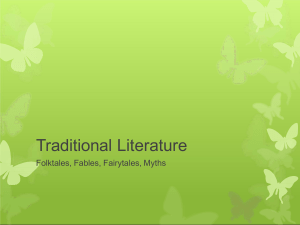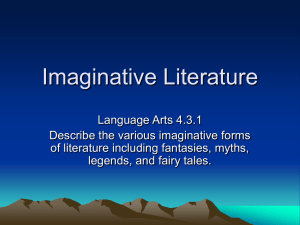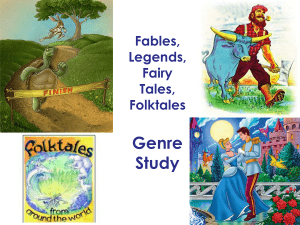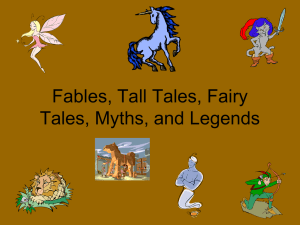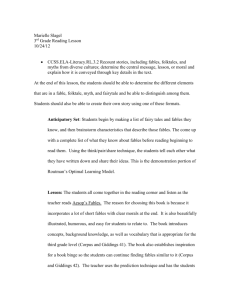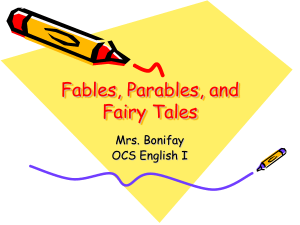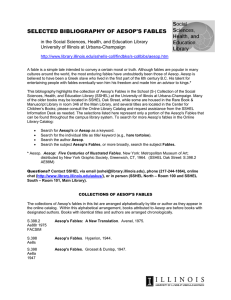Traditional Literature
advertisement
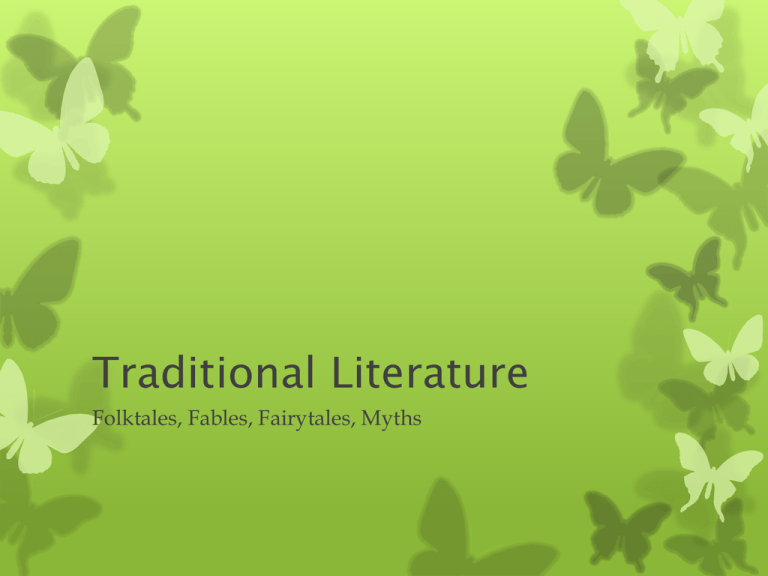
Traditional Literature Folktales, Fables, Fairytales, Myths Why learn about Traditional Literature? Serves as the building blocks for contemporary literature/framework for literature Provides a window on diverse cultures Provides moral models for children as the struggle between good and evil is applied to events in their own lives Folktale A story told by word of mouth to teach a lesson Passed down from generation to generation https://www.youtube.com/watch?v=ceq Mz_dKlzA Folk tale Folktales feature common people, such as peasants, and commonplace events. Characters representing human frailty (being fragile). Characters represent human qualities Good Evil Wisdom Foolishness Laziness Etc. Folktales The conflict of the story is clear. The resolution usually has happy endings Good is rewarded and evil is punished Elements of magic or magical characters may be incorporated, but logic rules so the supernatural must make sense in the story. Fables Short stories that teach a moral (lesson) Plot is very brief, with one event. Animal characters with human characteristics Characters are flat, and stand for one human trait. Themes: cooperation, understanding, acceptance, etc. Morals sometimes are inferred. May be expressed in a proverb. https://www.youtube.com/watch?v=MeZe2qPLPh0 Aesop's Fables a collection of fables credited to Aesop, a slave and storyteller believed to have lived in ancient Greece between 620 and 560 BCE. Of diverse origins, the stories associated with Aesop's name have descended to modern times through a number of sources. Aesop's Fables This famous Book of Fables, which are always referred to as Aesop's Fables, date back to the 5th Century BC. Lion and the Mouse The Fox and the Crow Goose with the Golden Eggs Wolf in Sheep’s Clothing The Town Mouse and the Country Mouse Ant and the Grasshopper https://www.youtube.com/watch?v=TzyvmC1FAt0 https://www.youtube.com/watch?v=gKWktweAZb0 Fairytale Elements of a Fairytale Contains magic/enchantments Likely character types: Talking animals Witches Fairies Nobles (Kings, Queens, Princes, Princesses) Godparents Fairy Tale- setting Setting does not have a definite location or time Familiar fairytales look like Germany https://www.youtube.com/watch?v=68eUVT2H4YY The best know tale in the World Cinderella The oldest known version was found in China in the 9th century. It is basically a story of sibling rivalry. There are over 700 different versions. Hans Christian Anderson • Danish author and poet • Wrote more than 160 Fairy Tales • Many of Andersen's fairy tales depict characters who gain happiness in life after suffering and conflicts • Ugly Duckling theme of self-discovery, which matched his own life • Optimistic belief in the triumph of the good • Known as the father of the modern fairytale Click on Anderson’s picture to see his stories Brothers Grimm Click picture for Grimm stories Jacob Ludwig Carl Grimm and Wilhelm Carl Grimm Wrote children’s tales and folklore to preserve German culture/heritage Wrote 211 stories together More stories Fractured Fairy tale When authors modernize or change one or more of the elements of the story, the story is called a fractured fairy tale. Plot (conflict, rising action, climax, falling action, resolution) Setting (time and/or place) Character (name, character traits) Point of View Theme Fractured Fairy tales Fracture Fairy Tales on the screen Myths A mythology is a related body of stories which make up the official beliefs or explanations of a religious system. Myths attempt to explain the beginning of the world, natural phenomena, the relationships between the gods and humans, and the origins of civilization. Myths, like legends, are stories told as though they were true. Myths Ancient Civilizations stories and beliefs
